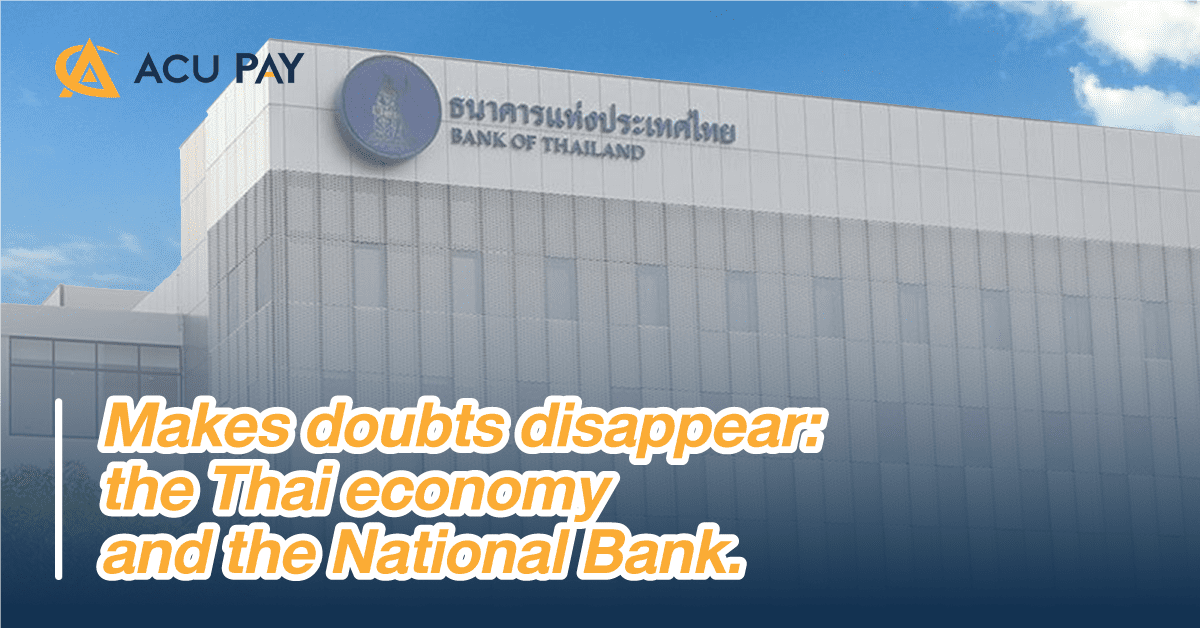

As we know that the world economy is now highly volatile. Every country has a difficult economic situation. The question is, how is the Thai economy? Let’s take a look at the answer from the Governor of the Bank of Thailand.
Recently, the Thai economy has clearly recovered through consumption in the private sector and the tourism sector. After the government relaxed measures. And the recovery is expected to continue, with GDP in 2022 and 2023 expected to be at 3.3% and 4.2%, respectively. The labor market gradually improved. The number of unemployed and virtually unemployed is expected to fall to 2.4 million in 2023, close to pre-COVID levels of 2.3 million. Non-farm payroll income is expected to rise 12% this year from an 18% contraction in 2020. However, the recovery in each economic sector is not yet comprehensive (K-shaped). Export-related businesses have recovered well beyond the pre-COVID period. while tourism-related businesses recover faster than expected. but still much less than before COVIDS. This year, the number of tourists is expected to be 6 million, or 15% of the number before the coronavirus.
Inflation is likely to rise due to supply-side factors, with oil prices rising mainly from the Russo-Ukrainian War. It has been observed that the passed-on costs more in the country and has been distributed to many product categories. including the category in the inflation group. For example, the price of fresh food and cooking gas was passed on to the price of packaged food. The cost of chemicals, packaging, and shipping was passed on to the prices of personal care items, with headline inflation in 2022 and 2023 expected to be 6.2% and 2.5%, respectively. Looking forward, inflation is still at high risk due to rising costs at the same time. including the result of an increase in the minimum wage, the transmission may be much faster than expected. There may be demand pressures that will accelerate following the economic recovery going forward.
The economic context has changed a lot compared to the COVID-19 crisis. Consequently, monetary policy and monetary measures must be adjusted in line with the economic and monetary conditions and a new risk balance that gives more weight to inflation.
The key goal of the policy implementation during this period is to continuously recover the Thai economy without interruption. And in order to achieve that goal, there are two main parts that we would like to see:
That the banking system will not stumble, it must be seen that
(1) Banks have a strong position, NPL must not accelerate so quickly that the banking system cannot manage. Currently, the NPL ratio of the banking system is still low as of May 2022 at 2.96%, down from 3.04% in the pre-COVID period in Q1/2020. (BIS ratio) at 20%, liquid assets to cover potential cash outflows (LCR) at 190%, and NPL coverage ratio of 166%.
(2) The debtor survived as much as possible. The measures must be on point. use resources appropriately because it will help the bank to survive.
The key goal of the policy implementation during this period is to continuously recover the Thai economy without interruption. In order to achieve the goal, there are two main parts:
On the other hand, if inflation rises further but we haven’t raised interest rates yet. This will reduce the actual borrowing costs. The policy rate is currently negative at 5.70%2 and business borrowing costs through bond issuance are negative 4.3%, much lower than the last year’s 0.2%.
Raising interest rates that won’t stall the economy should be done early when there is a signal. Because the transmission of monetary policy takes time, if it is too slow it can lead to inflation. and have to raise interest to take care of later, which will be more detrimental to the economy and people.
Now that the economy is in its early stages of recovery, inflation is not much. Medium-term inflation expectations remain within the target range, so Thailand’s interest rate hike is not too late. In addition, interest rate hikes should be done gradually. No need to speed up interest rates because it will cause financial costs to rise too quickly. causing the people and the business sector to not adjust and caused the economic recovery to stumble. which is what we don’t want most.
However, the policy interest rate hike in Thailand is not necessarily in line with foreign countries. Because the economic and financial contexts in this period are different, such as the US economy. It has recovered better than the pre-COVID period since the first half of 2021, and inflation has risen considerably from strong domestic demand. Therefore, the interest rate has to be accelerated to take care of the economy. while Thailand has just begun to recover, raising interest rates has to be done gradually to achieve a smooth take-off.
2. Financial Measures That Have Wide Effects Must gradually adjust to normal conditions. At present, the financial institution’s position remains strong with sufficient capital, liquidity, and reserves to cover future risks. While taking measures for too long can have side effects on the financial system in the long run, therefore, measures should be adjusted to return to a more normal level as follows:
(1) Repeal the limitation of dividend payment rates. by also allowing financial institutions to consider the dividend payout ratio in accordance with the operating results and risks that may occur in the future; and
(2) Adjust the remittance rate to the FIDF fund back to 0.46% per annum, effective from 2023.
Bringing the measure back to normal has side effects, but it’s worth it. Depositors earn higher returns while some debtors receive floating interest, although higher interest payments have the effect of increasing interest on household expenses less than the effect of inflation. That reduces the purchasing power of the people. The Bank of Thailand’s assessment found that a 1% increase in borrowing rates would increase the interest burden on average indebted households by 0.5%, compared to an increase in household expenses due to inflation of 3.6%. The effect of the interest rate increase is greater than 7 times.
Furthermore, in the case of old debtors, If it’s a microloan, about 60% already have a fixed rate, such as hire purchase loans and credit cards. While home loans have most of the interest float, the monthly payment is already set. Whereby the financial institution has already increased interest rates, that may increase them in the future. This group will not be affected. While almost all business receivables are floating interest based on the M-rate, In the case of new debtors, they will be affected by higher interest rates, so debtors should assess their income and expenses before taking on new debt.
However, there are still vulnerable debtors, such as retail debtors with unsecured loans. The Bank of Thailand continues to take the following steps to assist debtors:
1. support specific measures that are still in effect, including debt relief via primary measures, which are the long-term debt settlement measures on September 3, which are still effective until the end of 2023; pause loan measures effective until the end of April 2023; and re top-up measures that are effective until the end of April 2023. as well as ways to help debtors with debt repayment problems. It can be seen that most projects are in effect at least until 2023. The Bank of Thailand is ready to adjust the measures to be more flexible with the expected economic recovery. according to the situation and context of the debtor.
2. Increase measures to take care of vulnerable retail debtors, especially those in the unsecured loan group, which have been affected by the income that has not yet fully returned and the higher cost of living by adding measures to address the problems of each group of debtors. For the group that has not yet been in bad debt to maintain a minimum credit card repayment rate of 5% until 2023 and to maintain the extension of the repayment period of digital personal loans at 12 months for another year until 2023. The bad debt group will change the debt repayment program of the Debt Clinic by adding repayment options so that debtors who are still paying can end their debts faster. The debtor who chooses a repayment plan with a short period It will receive lower interest rates and there will be a Debt Mediation Fair for credit cards, personal loans, hire purchase loans, pledged registration, and nano finance in the 3rd quarter of this year.
Overall, the Bank of Thailand’s policy adjustments and financial measures in the next phase will focus on a view of the financial and economic economy that is linked and flexible according to the situation
——————————————————–
Reference : bot